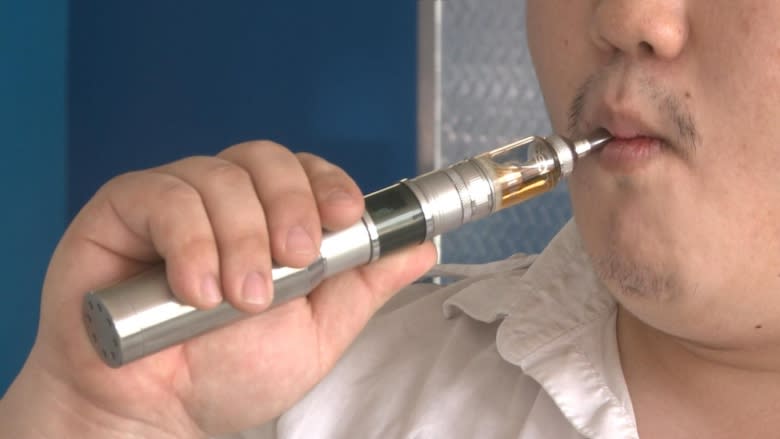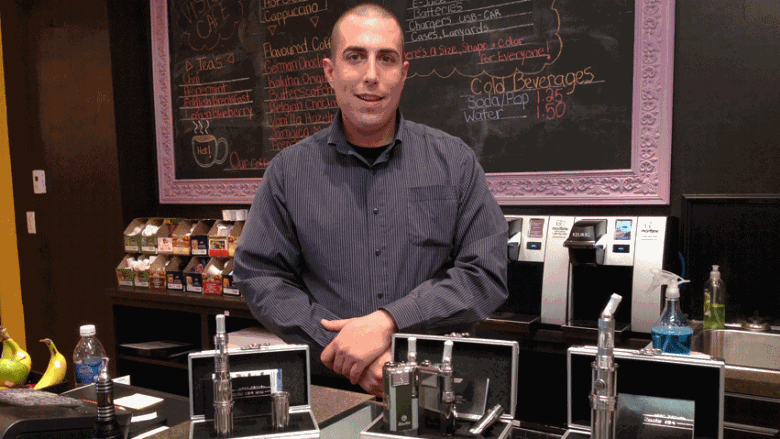E-cigarette market on fire while scientists wage heated debate
Electronic cigarette use is skyrocketing, revenue has reached the billions of dollars, legislators are talking about — and enacting — regulations, and more and more research is published every month.
But the jury is still out on their safety, and whether they are a gateway to smoking.
Earlier this week, the New York Times highlighted a growing concern that the tobacco industry is taking over the business and targeting kids with flavours that sound like candy as well as advertisements featuring cartoon characters or celebrities.
Meanwhile, the less reliable Daily Mirror in Britain focussed on the danger of explosions when e-cigarettes are plugged into the wrong charger, citing half a dozen examples to back up its worries.
For those not up on this newest trend, an e-cigarette includes a battery, heating coil and a cartridge containing e-juice. That's the liquid that may or may not contain nicotine and which gets vaporized when the battery powers the coil to heat up the liquid.
The vapor gets drawn up by the wick when someone inhales, and there is no smoke, so it's called vaping.
The pros and cons of vaping are hotly debated by scientists, and there is a wide range of experience among those who have tried it.
Vaping may increase smoking
For some, like Anna Camara, it may even lead to increased smoking.
Last year, an acquaintance she would see at the off-leash area for dogs in a Toronto park persuaded Camara, an eight-cigarette-a-day smoker, to follow her example and abandon smoking for vaping.
Camara invested $80 in the technology and the e-juice, with nicotine, but felt that vaping wasn't delivering enough nicotine to satisfy her need. So she would also smoke a cigarette.
She calculated that vaping would be cheaper than smoking, but it didn't help her to quit, and it also irritated her throat. (She had tried to quit before by using a nicotine patch, but found it too strong.)
In the end, she blames the vaping experience for doubling the number of cigarettes she smokes to about 16 a day.
On the other hand
E-cigarette proponents claim that because the physical act of vaping more closely resembles smoking, and because the nicotine intake can be adjusted, it should be a better tool to help a smoker quit the habit.
That's what Winnipegger Matt Clinch found. He says e-cigarettes are "fantastic."
In 20 years of puffing, he was up to a pack a day. But then he tried e-cigarettes and hasn't had a smoke in seven weeks.
He says he feels better, he isn't out of breath as much as he was and food is starting to taste better.
"It's as close to smoking as you can get without lighting up and smelling like an ashtray."
He says the battery charge lasts him until dinner time and then he has to charge the unit for four hours, which he calls "a good thing, because it keeps me from over-using it."
Cheaper than cigarettes
Clinch also likes the fact that the juice comes in a variety of flavours and levels of nicotine, because "it makes cutting back your nicotine intake easier, without really realizing that you're cutting back."
He estimates the start-up costs of vaping as equivalent to a carton of cigarettes. But now he's down from spending $17 a day on cigarettes to 75-80 per cent less buying e-juice.
Nick Cooke, a Canadian living in Nicaragua, is discovering the same thing.
He has been using a vaporizer for a little more than a year and says vaping is "way less worse for me than the 30 to 40 cigarettes I used to smoke each day.
"It's odourless and smokeless for the people around me, so it's no problem to have a puff in a restaurant or bar or airport boarding lounge."
Cooke also can have just one or two drags on the e-cigarette and then set it aside.
He says that even in Nicaragua, where cigarettes are cheap ($1.75 for a pack of 20), he's saving money by vaping.
"The only disadvantage is not always having a lighter in my pocket, which comes in handy during power outages."
Doubts about safety
In Canada, selling e-cigarettes with nicotine or those with a health claim is not authorized, though selling e-cigarettes or e-juice without nicotine is legal.
In an email to CBC News, Health Canada said, "To date there is not sufficient evidence that the potential benefits of e-cigarettes in helping Canadians quit smoking outweigh the potential risks."
In order to get a vaping product authorized, Health Canada requires a company "to provide evidence of safety, quality and effectiveness" - a regulatory hurdle that is "among the most restrictive in the world," according to an editorial last year in the Canadian Medical Association Journal. (It wants e-cigarettes to be regulated as pharmaceutical rather than tobacco products.)
Winnipeg-based Theravape Inc. is one of about a dozen established juice-makers in Canada.
It is just Eden Sorrell and two friends working there and they manufacture and sell wholesale at least 13 different flavours of e-juice.
Their best sellers include lychee, menthol and tobacco. Sorrell describes the tobacco flavor as "transitional."
All their flavours can come with or without nicotine, and the nicotine can come in different strengths. Theravape e-juice sells for about $1 a millilitre.
Asked about Health Canada's policy, Sorrell explains that e-cigarettes with nicotine are "not authorized for sale but not prohibited. It's a grey market item."
He says his company doesn't get hassled by Health Canada "because it's actually marketed as a chemical consumer product, not as a health-care product."
Sorrell, who also works as a nurse, and is a non-smoker, explains that "it takes longer for nicotine to hit your bloodstream from a vape than it does from a cigarette, because it's being absorbed through the mucous membranes in the mouth, not within the lungs."
Tobacco industry dominates
One of the issues under debate among scientists is whether vaping could serve as a so-called gateway to smoking.
Sorrell says Theravape is "not here to start new habits" and he is unaware of any non-smokers trying their product.
Nevertheless a concern in the medical community is that e-cigarettes will be "a Trojan horse that will allow the tobacco industry to reverse decades of global progress in reducing smoking prevalence," says the CMAJ editorial.
"The tobacco industry sees a future where e-cigarettes accompany and perpetuate, rather than supplant tobacco use," the editorial adds.
The tobacco industry dominates the e-cigarette industry. In the U.S., a company called Blu eCigs accounts for almost half of all e-cigarettes sold, and it is in the process of being acquired by Imperial Tobacco.
The tobacco industry also dominates the e-cigarette industry in Europe, where vaping is more popular.
In the British documentary, "The Rise of the E-cigarette," Kingsley Wheaton, a director at British American Tobacco (which sells Vype e-cigarettes), says e-cigarettes "provide a substantially safer alternative to smoking a traditional cigarette."
Although that may sound like a good reason to stop smoking, there is intense debate among scientists around the world about whether vaping will lead to smoking cessation.
In May, 53 public health specialists wrote to the World Health Organization, arguing that e-cigarettes could provide what they called tobacco harm reduction because, in vaping, nicotine is consumed in a low-risk, non-combustible form and doesn't draw tar and toxic gases into the lungs the way smoking tobacco does.
That started a vigorous scientific exchange, starting with a rebuttal from 129 other public health and medical authorities, then a reply from the first group.
Reading those three letters gives an understanding of the debate, and its intensity.
The points in contention include the safety of the liquid, the safety of the second-hand vapor, and whether e-cigarettes are just another way of perpetuating smoking.
They don't debate the harms of the nicotine. By now that's pretty well understood.




